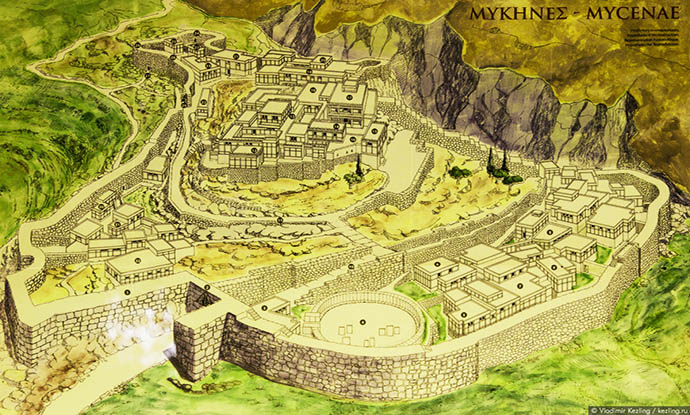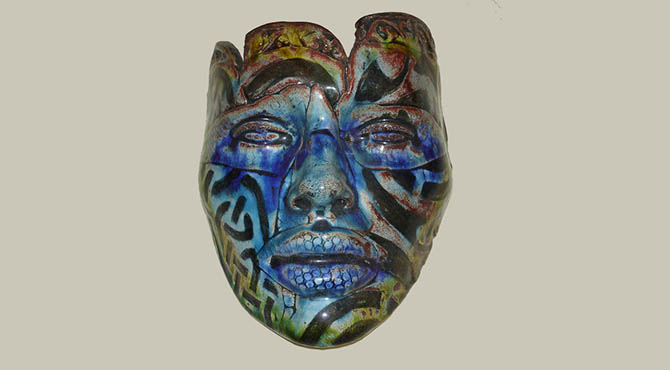
At hill top on the peninsula of Peloponnese settlement ruins lie. It is Mycenae – the most ancient city of Greece, Agamemnon’s citadel. Mycenae – the oldest city of the mainland of Greece. Is more ancient only Knossos, the center of a Minoan civilization in Crete. The first excavation in Mycenae was made in the 1840th years, but the most interesting finds were made by Heinrich Shliman who got to work in 1874. Shliman was sure that the gold stamping mask found him – a posthumous mask of the tsar Agamemnon, the conqueror of Troy according to homeric “Illiada”. One of the most sensational events in the history of archeology took place on December 6, 1876 when the German businessman and the amateur archeologist Heinrich Shliman in search of legendary Troy opened in Mycenae the first of five filled with – krovishcham of the ancient mine burial grounds which were settling down on the ground known now under on – a rank “A sepulchral circle And”. At excavation remains of 19 people were found. Near them gold jewelry, the bronze weapon inlaid with gold and silver, gold breast plates and gold, and silver cups lay. The magnificent gold mask which, on his belief, was a posthumous mask of Agamemnon was the most magnificent find of Shliman, in the Mine burial ground of V. According to the Greek poet Homer living in the 8th century BC, Agamemnon was the tsar Akhei (which identity with Mycenae is established) and the leader of the Greek army in Trojan war. Shliman immediately sent to the Greek king the enthusiastic telegram: “I saw Agamemnon’s face”. During excavation Shliman found a set of expensive and unusually beautiful jewelry. These finds demonstrate that the Mycenaean aristocracy owned huge riches. The city architecture confirms conclusions of scientists: the Mycenaean culture was exclusively developed. The city of Mycenae was the center of this great civilization which existed about 500 years, from 1600 to 1100 BC. It succeeded Minoan culture in Crete and dominated in the states of the Aegean Sea and beyond its limits. A Mycenaean pottery was found very far from the city, for example in the Southern Italy, in Cyprus, in Egypt, Syria and Palestine. Shliman’s confidence that he found Agamemnon’s grave probably was based on works of the Greek geographer Pavsaniya living in the 2nd century AD. He claimed that Agamemnon was buried in the city, and his murderers Klitemnestra and Egisf are buried behind city walls – such burials archeologists nowadays call tolosovy. The ulyeobrazny false arch is characteristic of them. Shaft tombs from “A sepulchral circle A” really are in city walls, under a market square, however modern methods of research carry them approximately to 1600 BC. This time dates also “Agamemnon’s mask” which was only one of several gold masks found later. Trojan war if these events took place actually, but were not a fruit of imagination of Homer, it was conducted about 1200 BC, approximately in 400 years after in mine graves of Mycenae the found remains and treasures were buried. Mycenaean fortress held very advantageous strategic position, it towered over the plain Argos and controlled all mountain passes to the North, to Corinth. The main entrance to the city was decorated by the Lion’s gate built about 1260 BC. Over them two big stone lions were cut. All construction the roof which length made 8 m, height – 90 cm, and width – 2,4 m crowned. From gate there was a road to the imperial palace. Its walls decorated by frescos, like Creete lists. Thus, residents of Mycenae had an idea of Minoan culture. Around houses of less high-ranking citizens were restricted. One of them, the so-called House with columns, was three-storyed. Out of fortifications there is “A sepulchral circle B”, system of tolosovy burials which age is not so respectable as age of mines in “A sepulchral circle A”. The Tolosovy burial ground can consist of 35 rows of a circular laying. Huge stones lie one on another, and each following stone ring of already previous. In the ancient time in the same way built beehives. Graves of this type were constructed for about 200 years, from 1400 to 1200 BC. Usually they were dug out in a hill slope. The huge aperture at the end of a long tunnel served as an entrance to a burial ground. After each burial pass was immured and the tunnel was covered with earth. The most interesting tolosovy burials of Mycenae are so-called the treasury of the tsar Atrey (father Agamemnon) and Klitemnestra’s grave. But though they also treat the “necessary” period, there are no real proofs that it is really their graves. About 1150 BC the Mycenaean civilization suddenly stopped the existence. The city was or is destroyed, or will leave for other reason. It was the last from early Greek cultures, and with its disappearance the country plunged into the era known under the name of “dark”.






Leave a Reply